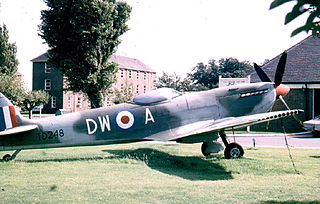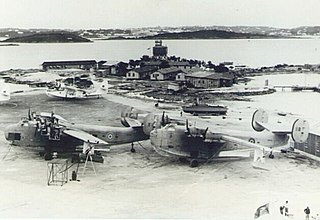The Special Operations Executive (SOE) was a secret British World War II organisation. It was officially formed on 22 July 1940 under Minister of Economic Warfare Hugh Dalton, from the amalgamation of three existing secret organisations. Its purpose was to conduct espionage, sabotage and reconnaissance in occupied Europe against the Axis powers, and to aid local resistance movements.

The British Commonwealth Air Training Plan (BCATP), or Empire Air Training Scheme (EATS) often referred to as simply "The Plan", was a massive, joint military aircrew training program created by the United Kingdom, Canada, Australia and New Zealand, during the Second World War. BCATP remains as one of the single largest aviation training programs in history and was responsible for training nearly half the pilots, navigators, bomb aimers, air gunners, wireless operators and flight engineers who served with the Royal Air Force (RAF), Royal Navy Fleet Air Arm (FAA), Royal Australian Air Force (RAAF), Royal Canadian Air Force (RCAF) and Royal New Zealand Air Force (RNZAF) during the war.
A fireteam or fire team is a small military sub-subunit of infantry designed to optimise "bounding overwatch" and "fire and movement" tactical doctrine in combat. Depending on mission requirements, a typical fireteam consists of four or fewer members: an automatic rifleman, a grenadier, a rifleman, and a designated team leader. The role of each fireteam leader is to ensure that the fireteam operates as a cohesive unit. Two or three fireteams are organised into a section or squad in co-ordinated operations, which is led by a squad leader. Historically, nations with effective fireteam organisation have had a significantly better performance from their infantry units in combat than those limited to operations by traditionally larger units.

Organisation Todt (OT) was a civil and military engineering organisation in Nazi Germany from 1933 to 1945, named for its founder, Fritz Todt, an engineer and senior Nazi. The organisation was responsible for a huge range of engineering projects both in Nazi Germany and in occupied territories from France to the Soviet Union during World War II. It became notorious for using forced labour. From 1943 until 1945 during the late phase of the Third Reich, OT administered all constructions of concentration camps to supply forced labour to industry.

The Ministry of Works was a department of the UK Government formed in 1940, during World War II, to organise the requisitioning of property for wartime use. After the war, the ministry retained responsibility for government building projects.

The Corps of Royal Electrical and Mechanical Engineers is a corps of the British Army that maintains the equipment that the Army uses. The corps is described as the "British Army's Professional Engineers".

MoD Sealand, is a Ministry of Defence installation in Flintshire, in the northeast corner of Wales, close to the border with England. It is a former Royal Air Force station, active between 1916 and 2006.
The Ministry of Supply (MoS) was a department of the UK government formed in 1939 to co-ordinate the supply of equipment to all three British armed forces, headed by the Minister of Supply. A separate ministry, however, was responsible for aircraft production, and the Admiralty retained responsibilities for supplying the Royal Navy. During the war years the MoS was based at Shell Mex House in The Strand, London.

The Royal Air Force (RAF) operated from two locations in Bermuda during the Second World War. Bermuda's location had made it an important naval station since US independence, and, with the advent of the aeroplane, had made it as important to trans-Atlantic aviation in the decades before the Jet Age. The limited, hilly land mass had prevented the construction of an airfield, but, with most large airliners in the 1930s being flying boats, this was not initially a limitation.
The London Transport Executive was the organisation responsible for public transport in Greater London, England between 1948 and 1962. In common with all London transport authorities from 1933 to 2000, the public name and operational brand of the organisation was London Transport.

Hucknall Aerodrome is a former RAF aerodrome located 5 NM north northwest of Nottingham, Nottinghamshire, England and west of Hucknall town. The aerodrome had been operated by the Merlin Flying Club since 1971, it is owned by Rolls-Royce Group PLC following previous ownership by both the Air Ministry and Ministry of Aviation.

Duxford Aerodrome is located 8 nautical miles south of Cambridge, within the Parish of Duxford, Cambridgeshire, England and nearly 1-mile (1.6 km) west of the village.

Heston Aerodrome was an airfield located to the west of London, England, operational between 1929 and 1947. It was situated on the border of the Heston and Cranford areas of Hounslow, Middlesex. In September 1938, the British Prime Minister, Neville Chamberlain, flew from Heston to Germany three times in two weeks for talks with Adolf Hitler, and returned to Heston from the Munich Conference with the paper referred to in his later "Peace for our time" speech from 10 Downing Street.
The Royal Air Force Volunteer Reserve (RAFVR) was established in 1936 to support the preparedness of the U.K. Royal Air Force in the event of another war. The Air Ministry intended it to form a supplement to the Royal Auxiliary Air Force (RAuxAF), the active reserve for the RAF, by providing an additional non-active reserve. However during the Second World War the high demand for aircrew absorbed all available RAuxAF personnel and led the RAFVR to quickly become the main pathway of aircrew entry into the RAF. It was initially composed of civilians recruited from neighbourhood reserve flying schools, run by civilian contractors with largely RAF-trained flying instructors as well as other instructors in related air war functions, such as observers and wireless operators.
The Aeroplane and Armament Experimental Establishment (A&AEE) was a research facility for British military aviation from 1918 to 1992.

Portsmouth Airport, also known as Portsmouth City Airport, PWA and Hilsea Airport, was situated at the northeast Hilsea corner of Portsea Island on the south coast of England and was one of the last remaining commercial grass runway airports in the United Kingdom.

The US Army Air Forces in WWII had major subordinate Commands below the Air Staff level. These Commands were organized along functional missions. One such Command was the Flying Training Command (FTC). It began as Air Corps Flying Training Command on 23 January 1942, was redesignated Army Air Forces Flying Training Command (AAFTC) on 15 March 1942, and merged with Army Air Forces Technical Training Command to become Army Air Forces Training Command on 31 July 1943. Continuing service after the war, it was redesignated Air Training Command on 1 July 1946. During the consolidation of Air Force Major Commands in the retrenchment of the 1990s, Air Training Command assumed control of Air University and became Air Education and Training Command on 1 July 1993—today's Air Education and Training Command (AETC), which celebrated its 75th anniversary 23 January 2017. see the Lineage and honors statement for AETC.
The Civilian Repair Organisation (CRO) was a branch of the British Air Ministry, formed in 1939 to co-ordinate maintenance and repairs of military aircraft by civilian firms.

Southern Rhodesia, then a self-governing colony of the United Kingdom, entered World War II along with Britain shortly after the invasion of Poland in 1939. By the war's end, 26,121 Southern Rhodesians of all races had served in the armed forces, 8,390 of them overseas, operating in the European theatre, the Mediterranean and Middle East theatre, East Africa, Burma and elsewhere. The territory's most important contribution to the war is commonly held to be its contribution to the Empire Air Training Scheme (EATS), under which 8,235 British, Commonwealth and Allied airmen were trained in Southern Rhodesian flying schools. The colony's operational casualties numbered 916 killed and 483 wounded of all races.

Women in the Second World War took on many different roles during the War, including as combatants and workers on the home front. The Second World War involved global conflict on an unprecedented scale; the absolute urgency of mobilizing the entire population made the expansion of the role of women inevitable, although the particular roles varied from country to country. Millions of women of various ages were injured or died as a result of the war.












